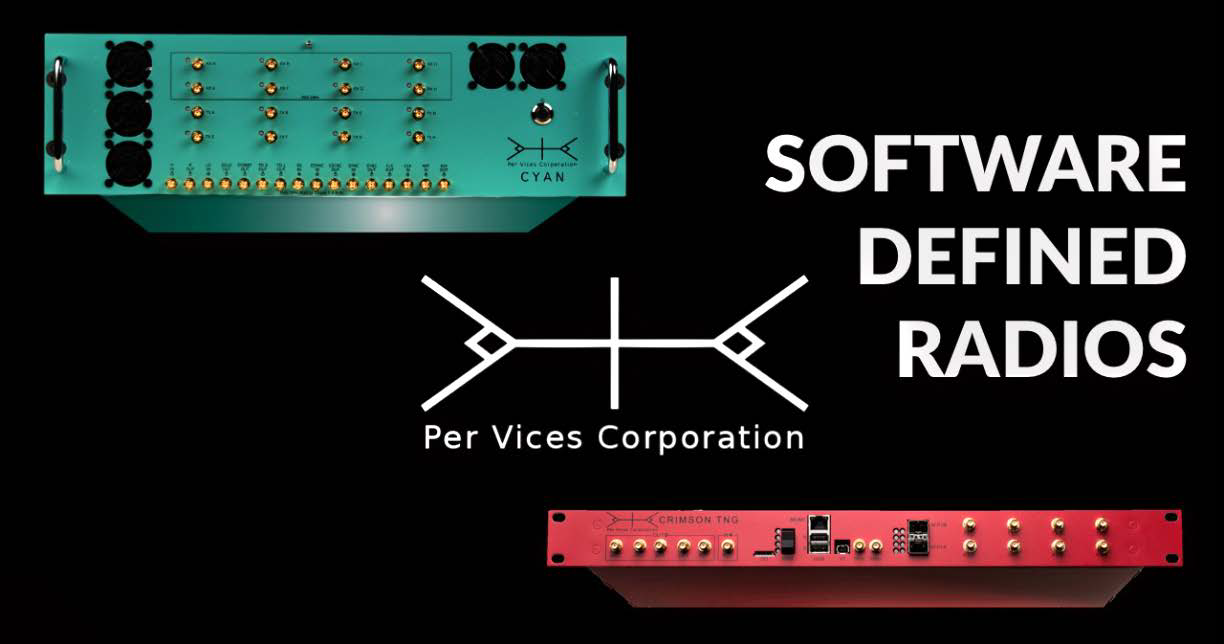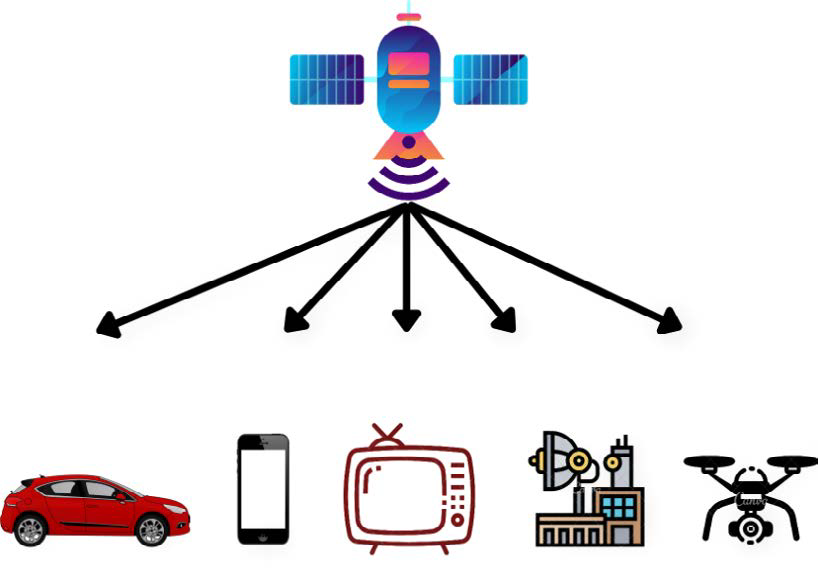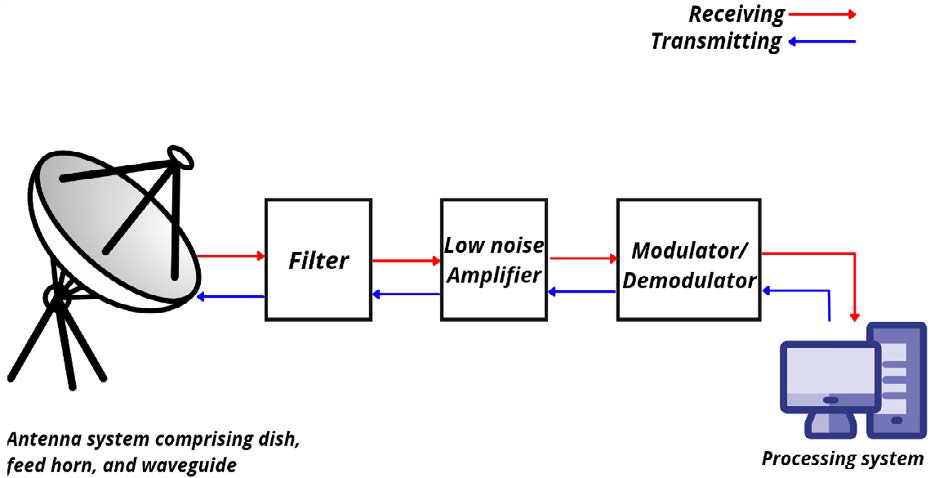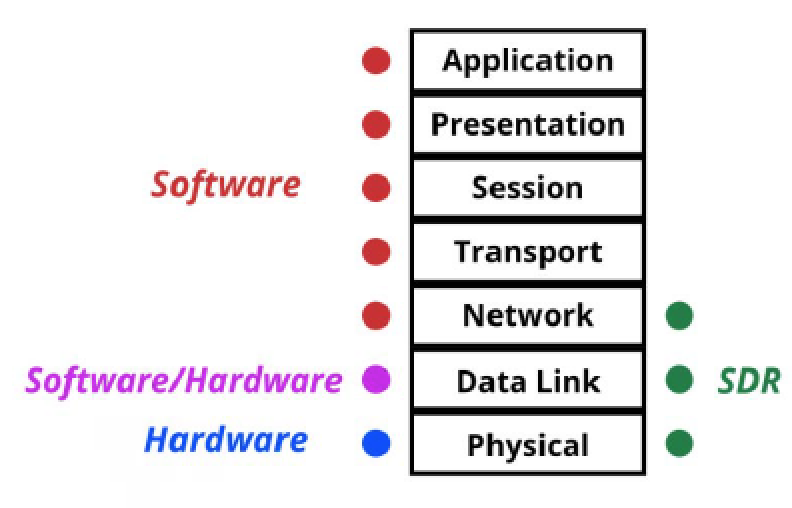Traditional satellite RF communication systems can often have drawbacks. Software-defined radio can be used in satellite systems as a replacement for these traditional platforms, and have numerous benefits.
This function, which involves the collection and transfer of data, is enhanced with different accompanying systems and technologies that enable satellites to be used in numerous applications across various industries, like the ones represented in Figure 1.

These industries and applications include GNSS (Global Navigation Satellite Systems), telecommunications, broadcasting, scientific research, metrology, data communication, and various military applications.
Satellite communication is achieved using extensive RF (Radio Frequency) communication. A satellite’s RF communication system is responsible for receiving, transmitting, and, in certain cases, processing data. It is also responsible for tracking, monitoring, and securing satellite capabilities.
Satellite communications (SATCOM) use frequencies in the L-, S, C-, X-, Ka-, Ku-, and V-bands, and numerous frequencies exist within each of these bands. Currently, there are more than 3,000 active satellites orbiting the Earth and these utilize different frequencies.
The major benefit of RF technology for SATCOM is the long-distance over which signals can travel. However, signals from space are quite weak — if there’s too much interference, they cannot be received by RF equipment.

Figure 1: There are various satellite applications and end-user devices.
To prevent interference between the over 3,000 active satellites and to ensure the optimal operation of each satellite, frequency assignment, regulation and protection are carried out by the ITU and the IEEE.
These bodies, along with other regulatory bodies, are responsible for regulating the usage of RF bands and assigning frequencies.
They are also responsible for creating satellite communication standards that standardize processes, systems, and equipment relating to all types of satellite communication systems, services, A SATCOM system comprises various subsystems that perform different functions. One of these subsystems which performs modulation and demodulation is the satellite modem. These devices perform modulation using schemes such as Binary phase-shift keying (BPSK), Quadrature phase-shift keying (QPSK),and Offset quadrature phase-shift keying (OQPSK).
These modulation schemes also indicate satellite communication standards that include framing formats, such as MPEG-2 used in digital video broadcasting (DVB) andE1/T1 systems for telecommunications multiplexing.
Satellite systems are comprised of three segments:
» The space segment comprising the on-orbit satellites
» The user segment comprising end-user devices
» The control segment, which primarily serves to monitor and control the satellites in space.
The control segment is typically a ground station with real-time, full duplex communication with satellites. The ground station is responsible for post-launch positioning, monitoring on-board and surrounding satellite conditions, station keeping, attitude control, position control, and systems updates.

Ground stations also serve to collect and stream data from satellites to users in various applications.
A ground station comprises various devices and systems that work together to perform its numerous functions. The first or last point of contact, depending on the operation (transmitting or receiving), is the antenna system.
Ground stations use large parabolic dish antennas that exponentially amplify, without adding significant noise, the very weak signals from distant satellites and focuses them on the feed horn, located at the dish’s center. A waveguide or hyperbolic reflector may be included in the antenna system for this operation.
The feed horn gathers and transfers the reflected signals from the dish to the filter for noise reduction before they are transferred to a low noise amplifier (LNA). After amplification, the waves are converted back to electric signals by the ground station’s modem and the electric signals are forwarded to a processing computer. Figure 2 on the previous page graphically describes this process.
A ground station also includes a TTC (Tracking, Telemetry, and Control) system that establishes a two-way link with the satellite’s TTC system.
Satellites are launched into three different orbits that differ by radial distance to the Earth’s surface. These orbits, in decreasing order of distance, are Geosynchronous Earth Orbit (GEO), Medium Earth Orbit (MEO), and Low Earth Orbit (LEO). Satellites in GEO move in synchronization with the Earth’s rotation, so ground station antennas for these satellites do not need to move, as they are always aligned with the satellite.
On the other hand, LEO satellites orbit the Earth several times a day. Ground stations use one of two types of antennas for these satellites. The first type are stationary antennas that only communicate with the satellite during the periods when the satellites are aligned with the antenna.
The other type are rotating antennas, known as trackers, that continuously rotate to follow the path of the satellite. Rotating antennas include driving gears and servo systems that facilitate rotation. Since the Earth and the satellite are rotating at different speeds, ground stations with rotating antennas require a system clock that ensures that the antennas are rotating at the correct speed to be in constant alignment with the satellite.
In addition to the RF system comprising transceiver/transponder devices for RF communication, in-space satellites also include several subsystems that are crucial to the satellites’ operation.
These subsystems include the power system, comprised of solar panels that provide power to the satellite; the RF communication-dependent TTC system that connects to the ground station for satellite monitoring, tracking, and control; and the propulsion system that makes occasional adjustments to keep the satellite in the correct position.
Satellites also contain the necessary devices for their particular application. For example, scientific research satellites contain data measuring and collection devices on board.
Traditional RF satellite communication systems in satellites and ground stations have numerous inherent drawbacks and threats. This is because these traditional platforms are comprised of mostly hardware systems.
In in-ground stations, one of the main problems is the lack of upgradability. The hardware used in traditional RF systems is usually dedicated, making even slight upgrades complicated. It is also challenging to repurpose a ground station for even a slightly different application using traditional RF hardware.
As well, calculating RF link budgets requires meticulous calculation in order to account for all gains and losses in RF signals. Furthermore, the focus on satellite technology has shifted to small, far less expensive satellites. These satellites use new bands such as UHF, S-, X-, and Ka-bands that older ground station equipment cannot use.
The higher frequencies allow larger amounts of data to be transmitted over stipulated periods but require antennas to be more focused.
Similarly, for on-orbit satellites, traditional hardware RF communication systems are bulky and cost ineffective, as the cost of launch is calculated per kg. While older satellites contained a single transceiver/transponder, capable of transmitting at a single frequency, today satellites and ground stations are required to be flexible, reconfigurable, upgradable/ updatable and possess wideband operation.
SDR as a Replacement for Traditional Platforms
The numerous drawbacks of traditional RF systems are eliminated and the requirements of modern-day satellites are met through the implementation of Software-Defined Radios (SDRs) for SATCOM. SDRs are highly functional RF communication systems wherein certain functions usually carried out by hardware, including modulation/demodulation and signal processing, are executed by software instead.
SDRs are comprised of a flexible radio front end (RFE) and a digital backend. The RFE contains the independent receive (Rx) and transmit (Tx) radio chains that can receive and transmit signals over a wide tuning range. In addition, these radio chains offer very high bandwidths, with the highest bandwidth SDRs, such as Per Vices’ Crimson TNG, offering up to 3 GHz per radio chain and up to 16 independent radio chains per SDR.
The digital backend contains an FPGA with onboard DSP capabilities for modulation, demodulation, upconverting, downconverting, and processing signals. The back end also possesses configurable and upgradeable capabilities for the latest radio protocols, DSP algorithms, etc. SDRs can contain multiple independent Tx and Rx channels with dedicated DACs/ADCs. Figure 3 (below left column) is an OSI model for satellite communications that shows where SDRs fit in.
SDRs offer numerous immense benefits in ground stations. One of these benefits is high independent channel counts with MIMO capabilities for uplinking/ downlinking multiple satellites.
MIMO SDRs make it possible for a ground station to communicate with various satellites simultaneously, irrespective of the satellites’ applications. For example, one channel can be used for navigation and another for scientific research data.
SDRs also provide ground stations with high flexibility, upgradability, reconfigurability, and interoperability. Legacy stations can be easily upgraded and repurposed. Similarly, processes and parameters such as modulation/demodulation, coding methods, and data rates can easily be reconfigured.
Customization can also be implemented effortlessly. The systems involved in the various applications of satellite communication undergo constant upgrades. This frequency of upgrades is matched by the high upgradability of SDRs.
SDRs can handle very high data rate streaming and recording services, including streaming to government, military, and commercial organizations for everything from reconnaissance to atmospheric weather conditions.
Also, the use of a DAC or ADC allows waveforms of any frequency (up to the limit of the converter) to be generated or interpreted. This is in contrast to a traditional radio, where a comparatively narrow band can be tuned.
Furthermore, SDRs can provide beam steering/beamforming for communicating more effectively with satellites. Lastly, SDRs are highly compact and offer reduced SWaP (Size, Weight, and Power). They are small, lightweight and consume relatively minimal power. These characteristics are especially beneficial in remotely located ground stations with limited power.
Likewise, the implementation of SDRs in in-space satellites provides numerous, incredible benefits in SATCOM. One of these is reduced SWaP requirements, owing to the highly compact nature of SDRs. SDRs significantly reduce the cost per launch of satellites compared to traditional bulky hardware systems. By including modems in their architecture, SDRs reduce the number of standalone equipment in RF communication systems. They also improve the overall operation of the satellites in space as they require limited power.
Furthermore, SDRs have significantly facilitated the development and usage of cubesats, small form-factor satellites with limited power and payload capacity but high functionality and low cost.

Figure 3: This OSI model for satellite communications shows where SDRs fit in.
SDRs can also be configured to various form factors for different payloads, for instance in cubesats. In addition to all these, SDRs are extremely rugged and radiation-resistant and area able to withstand the harsh conditions of space. Considering that satellites function in space for decades without any maintenance, this characteristic is particularly of benefit.
One of the most crucial implementations of SDRs is in the mitigation of cyber security threats. Cyberattacks, which can have grave effects, are becoming commonplace in various cyber- related fields, including satellite communication.
An attack on satellite systems, whether eavesdropping, spoofing, or hijacking, can have far- reaching grave consequences. SDRs can implement various processes to mitigate various cyber security threats, including authenticated communication, encryption of data in transmit, access control, logging and auditing, whitelisting and input validation, secure updates, anti-virus capabilities, BIOS security, and fail-safe capabilities.
All these capabilities are in place in SDRs to ensure that they provide safe and secure RF communication.
Other benefits of SDRs for in-space satellites include the FPGA’s ability to process multiple signals simultaneously independently and to modify the firmware to work with different constellations, in various frequency bands, with different modulation/demodulation schemes and in different applications.
Additionally, SDRs have advanced to the point of having multiple radio chains (as many as 16) that can simultaneously be operated at different frequencies. With a capable SDR, a single satellite can be used for as many as 16 different applications in different bands at the same time.
In addition, SDRs’ Forward Error Correction (FEC) transmits redundant data to help the receiver recover corrupted data. In its simplest form, FEC could transmit three bits for every bit of data.
Up + Coming Technologies Benefiting From SDR
SDRs are facilitating technological advancements in various fields and there are several up-and-coming implementations of the technology in various applications. One such application is satellite internet, a fast-rising application of satellite systems that involves the transfer of enormous amounts of data.
This application is made possible through SDR’s ability to transfer huge amounts of data with minimal latency quickly. While this technology is still in the development stage, companies such as Starlink and Viasat are already providing commercial options.
Another fast-rising application of SDRs is ground station sharing. Due to the increase in satellites in LEO, which can only make contact with ground stations for short, multi-periods a day, companies that share ground station access are growing These companies, such as Infostellar, are able to put ground station surplus communication capacity onto their cloud-based, protocol, and hardware agnostic platform. SDRs can benefit these systems due to the ability to work with multiple modulation/demodulation schemes in differing bands and stream data to cloud-based systems.
Headquartered in Toronto, Canada, Per Vices is a leading RF and digital systems innovator supplying multiple industries with wireless communication solutions. Per Vices is an industry leader in developing & deploying high-performance software- defined radio platforms with the highest bandwidth and customer-focused designs to support a wide variety of applications within defence, civil, aerospace, medical, telecommunications, low latency networks, global positioning (GNSS/GPS), radar, test & measurement, spectrum monitoring, and broadcasting & wireless management industries, offering the industry’s most advanced and cost effective stock products and rapid custom development to meet customer specific modifications and project and rapid custom development to meet customer specific mod requirements. Contact Per Vices at solutions@pervices.com.

